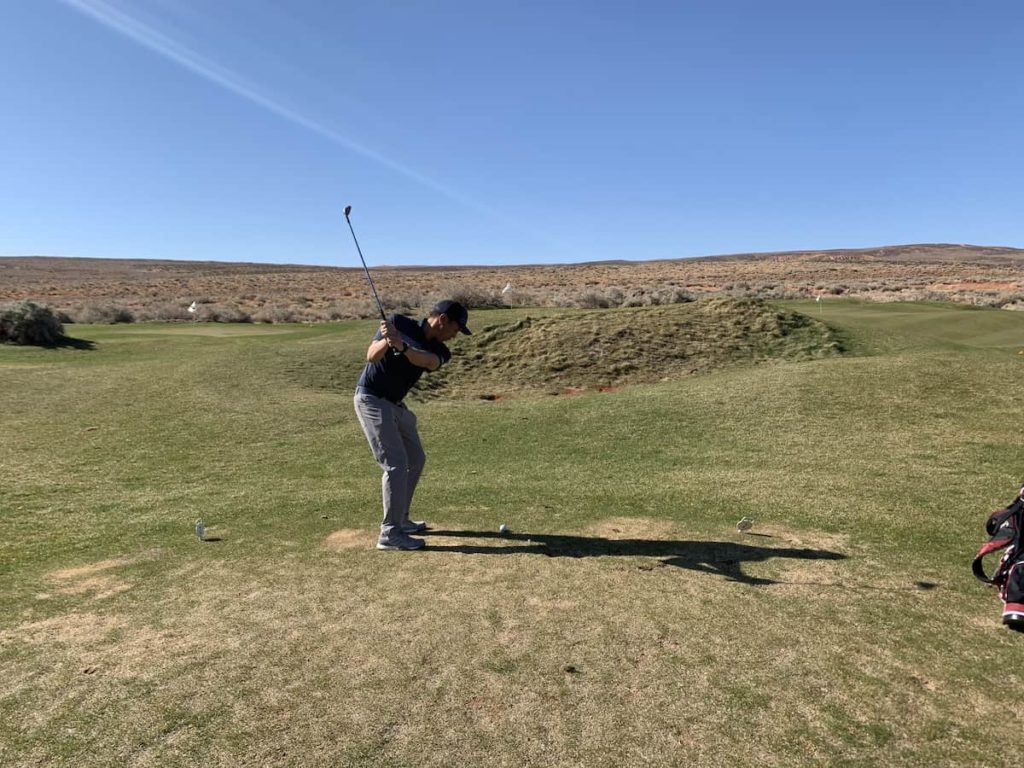As I stated in my Golf Chipping 101 post, the difference between chipping and pitching is that with chipping the ball rolls farther than it flies, whereas with pitching the ball flies farther than it rolls. So pitching and chipping shouldn’t be viewed as alternatives, but rather complements to a well-rounded short game.
Also similar to that post, I make a similar sports analogy when it comes to pitching a golf ball.
I explain it as simply as a baseball pitcher tossing the ball in the air. If you were to lob a ball in the air, that means a higher arc and smooth release. When we want to pitch a golf ball onto a green, we want height and arc on the ball flight with a bit of backwards spin and a good tempo swing. This means when the golf ball lands, the ball will not roll forward as much as if you were to chip the ball.
When we pitch our goal is to carry the ball over the rough or a bunker and land the ball softly onto the green. This means we want to be more precise on the distance we carry the ball. Pitching doesn’t require power so taking less than a full swing can be uncomfortable for many players.
This distance is usually under a full swing yardage of your highest lofted wedges so this swing requires touch, rhythm and understanding how your ball reacts off of your wedges. Through practice, you should know how your ball will react when landing on the green based on the height of your ball and how much backspin you put on it.
This means how high it will go and how much backspin you will create to know how the ball will react when landing on the green. How your manage your pitching approach shots is critical when managing a golf course.
Here is how I prepare when I’m approaching my next pitch shot.
Survey Your Pitching Situation
Check the Lie of the Golf Ball
Is it in the fairway or is the golf ball in the rough? If it’s in the rough, is the golf ball lying in high or short grass rough? Is the golf ball lying in dense grass or thin bare rough? Then check if the golf ball is sitting down in the rough or is it more on top of the rough?
We want to envision how the club will go through the rough so we can make better contact with the golf ball and how angled the ball will come off the clubface.
Check Hole Location on the Green
Check and see where the hole location is on the green compared to where your ball lies. You want to see how much green you have to work with. This means if the hole is closer to you on the green, you will have to pitch the ball higher with more spin.
If the hole location is on the further part of the green, you will have more green distance to land your pitch and have more options on your ball flight by flying the ball more towards the hole or landing it earlier on the green to let the ball roll more to the hole.
Decide What Club to Use
Using the first two factors, you will have to decide what club would be best to make consistent contact with the golf ball and how you want the golf ball to approach the green. Most players use their higher lofted clubs like the sand wedge, lob wedge or even the gap wedge. Read our How to Choose Your Wedges post for more detail.
I would recommend you practice with at least one of your wedges often in the practice area to get comfortable with the distances but more importantly how the ball launches off the clubface with the angle.
You may use the exact swing but with the different wedges so will see different results with the distance, launch angle and how the ball will react to landing on the green.
What Grip Should I Use?
Most players will use their regular grip from the full swing for pitching no matter what club you will be using. Just make sure the grip pressure stays light throughout the swing so you can still feel the clubhead and momentum through impact. You do not want to use your hands to determine how far you will the golf ball as this will not allow your hips and lower body to create a smooth tempo.
Pitching Stance
This stance can vary with all players but I tell my students to use distance to determine what the stance can be. There are usually two options when pitching into a green.
Open Your Stance
Rotate your body towards the target at set-up so your feet are pointing ahead of the ball a bit. If you are a bit closer to the green (approximately 20-40 yards), I would recommend this as we want to keep less body/turn in this short shot and put the body closer to the finish position before we even start.
You will also put a little more weight onto your side closest to the target. This will result in using the upper body more in the swing to create more consistency with contact, distance control and accuracy in this precise swing.
Square Up Your Stance
We want to keep your body square at set-up to use our lower body in this swing as the distance is usually farther away (approximately 40 yards to your full swing distance). Your weight can be distributed 50/50 on both legs.
The closer you are you can narrow your stance. The farther you are away, you can widen your stance. This will help in controlling your distance better by creating the necessary rotation in your swing.
Ball Position
Keep the ball in the middle of your stance. If you need a little more loft, move it slightly forward in your stance towards the target as you will also add a little more weight onto that side at set-up.
Pitching Stroke
I consider the pitching swing the base of your full swing. If you can pitch the ball well, your full swing should be very similar. It’s all about understanding that you don’t need to try and hit the ball hard but how to use the lower body properly to make all of your swings comfortable and balanced. When players have trouble with the shorter swings like a pitch shot, this tells me that they use more arms and hands than the lower body.
Backswing
- Start the swing with a one-piece takeaway using the shoulders and upper-body.
- Release the club much earlier depending on the distance. (Release means to let the clubhead slightly and gradually hinge your wrists)
- Your lower body will slightly rotate to transfer weight to your back leg.
- The transition we want to feel is now in the back hip/leg to start downswing
Downswing
- Be patient with the downswing! (don’t use your hands to help hit it) This will allow your legs and hips to start your downswing
- Your grip should still be loose so you can feel the clubhead lag behind as you are using your body turn forward to transfer the weight to your forward leg
- You will feel the clubhead snap/release at the ball (Means your arms, wrists, hands and club are extended at impact)
Follow-Through
- You will feel the impact effortless
- Still continue to get all or most of your weight to your forward leg with rotation and back heel will be pulled up
- Feel the club rolling over because of the body turn, don’t purposely use your hands to roll it over.
- You want to turn after impact with your club feeling centered on your torso. This will mean that your wrist angles will stay more in tact
- Club and hands will more likely be vertical and in front of you when holding your finish not behind your head


